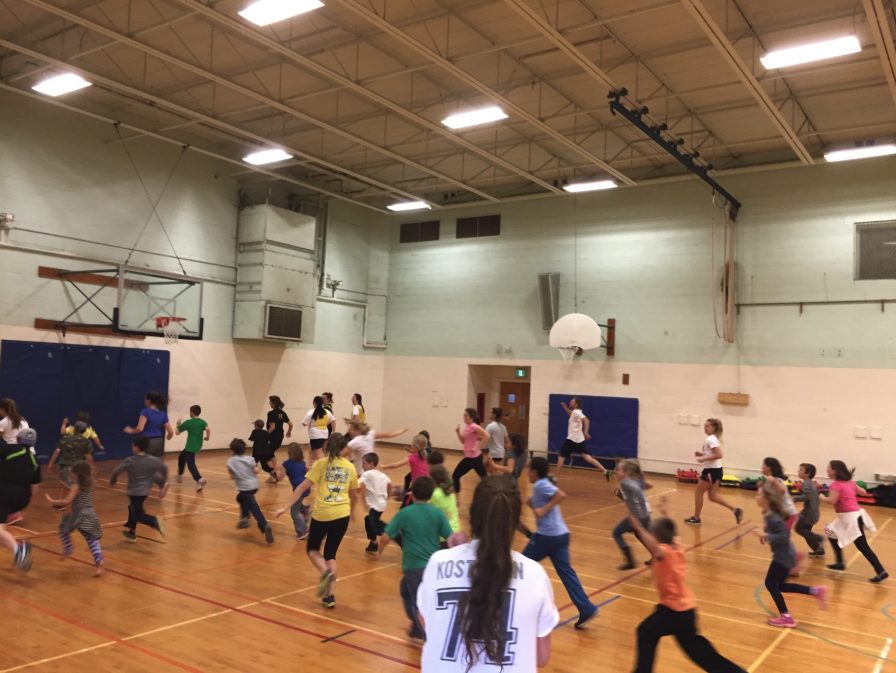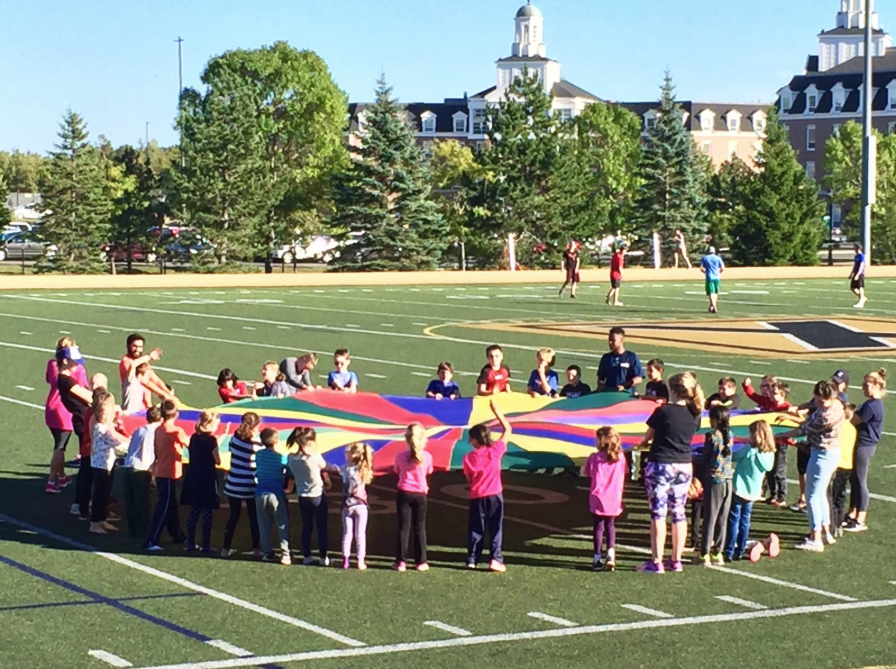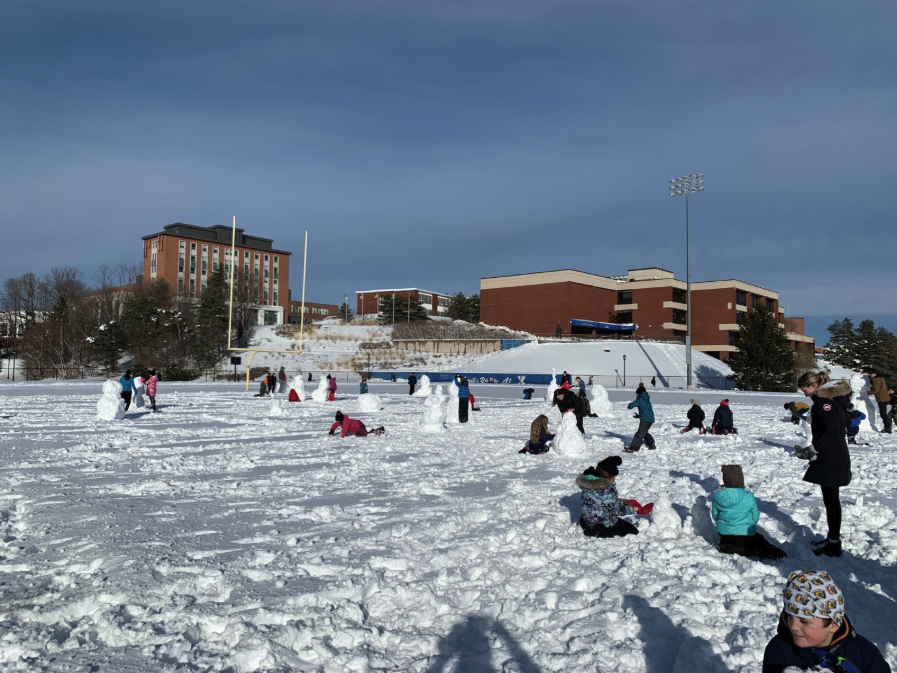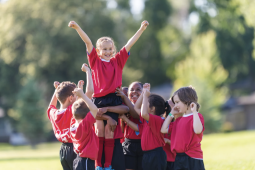Enhancing Confidence and Competence to Promote Physical Activity and Health in Children

Abstract
Service learning can facilitate learning how to promote physical activity and health to children. Mixed methods examined students’ perceived awareness, knowledge, confidence, attitude, and control in promoting physical activity and health to children in an after-school program, Fit 4 Life. University students (25 leaders; 22 control) provided pre- and post-program questionnaire data. Three focus group interviews and four one-on-one, semi-structured, in-depth interviews were conducted. Leaders increased their knowledge and confidence to promote physical activity pre- to post-program. Compared to the control group, leaders had significantly more knowledge to promote health and confidence to promote physical activity post-program. Thematic analyses of the interviews revealed four key themes: (1) confidence, (2) knowledge & skills, (3) teamwork & relationships, and (4) teachable moments. Volunteering with Fit 4 Life strengthened the leaders’ knowledge, confidence, and ability to promote physical activity and health to elementary school children while developing personal and professional skills.
Introduction
Canada’s 24-hour Movement Guidelines for children ages 5 to 17 years recommend 60-minutes of moderate-to-vigorous physical activity and several hours of light physical activity daily (Canadian Society of Exercise Physiology, 2020). After school physical activity programs play a critical role in creating physically active opportunities for children to reach these recommendations (Branscum & Sharma 2012; Elias et al., 2020; Wiecha et al., 2012). As such, preparing after school program leaders for the explicit purpose of creating opportunities to ‘Sweat’ and ‘Step’ is imperative (Burrows et al., 2014). After school program leaders need to be confident and knowledgeable in their work with children to facilitate enjoyment of physical activity.
Confidence in the skills needed to promote physical activity and health can be enhanced through education regarding how to ‘teach’ as well as the reminders of modeling what we teach – in essence walking the talk (Leurs et al., 2007). One example is an intervention created for childcare workers which resulted in increases in attitude and knowledge connected to the staff’s deliberation, confidence, and competence in promoting health to the children in their care (Elias, 2018; Elias et al., 2020). Further, the importance of role modeling was also highlighted where care providers recognized the positive influence they had on children’s health-related behaviours by actively participating with them (Elias et al., 2020).
Service learning is a pedagogical tool in higher education where connections can be made between volunteer services provided to community-identified need and academic learning. Following their service learning experiences, students indicated enhanced emotional awareness (Campbell & Oswald, 2018; Macías Gomez-Estern et al., 2021), and increased abilities to problem solve, express ideas, and be assertive when presenting relevant information (McNatt, 2019). Service learning allows mentors to support their students’ learning to work effectively in the community (Macías Gomez-Estern et al., 2021) while providing ‘hands-on’ experiences that textbook learning cannot (Campbell & Oswald, 2018; Macías Gomez-Estern et al., 2021; McNatt, 2019). Thus, the purpose of this research was to investigate university students’ service learning experiences with an after school physical activity program, Fit 4 Life on their awareness, knowledge, confidence, attitude, and behavioural control in promoting physical activity and health to children.
Methods
Context
Fit 4 Life is a two-hour an after-school program offered for the past 20 years at a small undergraduate university in Atlantic Canada three days a week for 10 weeks in the fall and winter academic terms by the coauthor and students engaged in service learning. The children are in grades 3 and 4 and participate one to three days per week while university student-volunteers, hereafter called leaders, commit to one afternoon per week. The 30-40 children who participated each day in this program were walked about 20-25 minutes from their elementary school to the university campus to take part in highly active and inclusive low organized activities facilitated by the leaders. Prior to the organized activities, and following 10-15 minutes of free play, the children were given fresh fruit as a snack.

Participants
Three separate yet interrelated studies provide the data for this paper. Research ethics approval was obtained for each study and the participants provided informed consent. Due to the hierarchical nature of the relationship between the co-author and the students – and in accordance with research ethics, she was not directly involved in data collection, nor did she have access to the data until after final grades were submitted for the term.
For the first study, students in a fourth year Human Kinetics course were emailed a letter of invitation prior to a verbal invitation in the classroom. Forty-seven of 58 (81.0%) eligible university students provided data. The consenting leaders from Fit 4 Life were one group (n = 25) while the consenting students not engaged in service learning were the control group (n = 22). Following completion of Fit 4 Life, the leaders were emailed a second letter of invitation to participate in focus group interviews. Of the 36 student-volunteers, 34 provided data (94%). Purposive sampling was then used to invite four leaders through another emailed letter of invitation to participate in one-on-one, in-depth, semi-structured interviews.
Procedures
For the first study, participants completed a pre- and post-program questionnaire modified from two previously validated questionnaires, the Healthy Opportunities for Preschoolers questionnaire (Naylor & Temple, 2013), and the School Health Facilitator Self-Efficacy Survey (Leurs et al., 2007). Modifications were made to better reflect the leaders’ roles in Fit 4 Life. As directed by Tsang et al (2017), the modified questionnaire was reviewed by three experts to ensure appropriateness and applicability. The pre- and post-program questionnaires were administered using Microsoft Forms during 10-15 minutes of class time. Completion of the questionnaire implied consent and provided anonymity.
For the second study, leaders participated in one of three focus group interviews held the week after Fit 4 Life on the same day and time as their volunteer experiences. These 45-75 minute focus group interviews had 10-12 leaders and took place in the same location, with participants sitting in a circle. Leaders responded to open-ended guiding questions regarding their learning while volunteering with Fit 4 Life. Detailed notes were taken by the lead author.
Four leaders agreed to participate in one-on-one, semi-structured interviews for the third study. Guiding questions encouraged in-depth responses regarding the leaders’ perceptions of their knowledge, confidence, attitude, and behavioural control when promoting physical activity and health during Fit 4 Life. These 30-60 minute interviews took place in a relatively quiet space on campus and were scheduled according to mutual availability. Verbatim transcriptions of the audio-recorded interviews were completed by the author and confirmed by the interviewees.
Data Analysis
Descriptive statistics were calculated for the pre- and post-program questionnaire data. Paired t-tests examined pre- and post-program responses within the Fit 4 Life leader and control groups. Equal variance t-tests evaluated the Fit 4 Life leader and control groups responses on the pre- and post-program questionnaire. Significance was set at p ≤ 0.01.
Focus group interview data were merged into one document according to the guiding questions. Using a phenomenological approach, both researchers read the responses several times with key words and phrases highlighted and grouped together to form potential themes connected to the lived experiences of the leaders. Similarly, following confirmation of the verbatim transcripts, the one-on-one interview transcripts were merged according to guiding questions and read several times by each investigator to find commonalities and differences.
Following their individual reading of the interview transcripts, the authors worked together to discuss their findings and to confirm themes that emerged from the interviews. These themes were further discussed and connected to the purpose of this study.
Results
Table 1 presents the questionnaire data. Compared to the control group, the leaders had significantly higher pre-program questionnaire responses for awareness and confidence related to general health promotion. The Fit 4 Life group also had significantly higher pre-program questionnaire scores for attitude and behavioural control to promote physical activity and confidence to teach. For the post-program questionnaire responses, the Fit 4 Life group had significantly higher knowledge to promote general health and significantly greater confidence to promote physical activity.
| Variable | Pre-Program Questionnaire | Post-Program Questionnaire | |||
| Fit 4 Life | Control | Fit 4 Life | Control | ||
| Awareness | PA1 | 4.79 ± 0.34 | 4.64 ± 0.42 | 4.81 ± 0.35 | 4.68 ± 0.40 |
| HE2 | 4.76 ± 0.48 | 4.57 ± 0.58 | 4.62 ± 0.55 | 4.66 ± 0.45 | |
| GH3 | 4.67 ± 0.30* | 4.35 ± 0.58 | 4.53 ± 0.46 | 4.55 ± 0.54 | |
| Knowledge | PA | 3.58 ± 0.63 | 3.59 ± 0.63 | 4.23 ± 0.50† | 3.99 ± 0.54† |
| HE | 4.07 ± 0.79 | 4.20 ± 0.75 | 4.48 ± 0.70† | 4.23 ± 0.65 | |
| GH | 4.23 ± 0.72 | 3.98 ± 0.75 | 4.61 ± 0.50*† | 4.30 ± 0.56† | |
| Confidence | PA | 4.32 ± 0.49 | 4.10 ± 0.61 | 4.46 ± 0.48*† | 4.11 ± 0.65 |
| HE | 4.48 ± 0.56 | 4.23 ± 0.77 | 4.64 ± 0.49 | 4.39 ± 0.63 | |
| GH | 4.46 ± 0.53* | 4.09 ± 0.61 | 4.61 ± 0.51 | 4.33 ± 0.64 | |
| Attitude | PA | 4.42 ± 0.41* | 4.18 ± 0.37 | 4.36 ± 0.43 | 4.27 ± 0.37 |
| HE | 4.19 ± 0.45 | 3.97 ± 0.51 | 4.20 ± 0.46 | 4.11 ± 0.36 | |
| Behavioural Control | PA | 4.33 ± 0.39* | 3.98 ± 0.41 | 4.35 ± 0.35 | 4.17 ± 0.46 |
| HE | 4.20 ± 0.35 | 3.97 ± 0.70 | 4.30 ± 0.43 | 4.16 ± 0.53 | |
| Confidence to teach | 81.40 ± 9.44* | 74.79 ± 8.89 | 81.94 ± 12.34 | 77.82 ± 11.93 | |
1PA = physical activity
2HE = healthy eating
3GH = general health
* indicates significantly different than control group
† indicates significantly different from pre- to post-program, within same group
Table 1 Pre- and post-program questionnaire responses (mean ± SD) for the Fit 4 Life (n=25) and control (n=22) groups.
The Fit 4 Life leaders reported significant increases in their knowledge to promote physical activity, healthy eating, and general health in their post-program questionnaire responses. The leaders also reported significantly more confidence to promote physical activity following their experiences with Fit 4 Life. The control group also reported significant increases in their knowledge to promote physical activity and general health in their post-program questionnaire responses.
Four major themes emerged from the interviews: (1) confidence, (2) knowledge & skills, (3) teamwork & relationships, and (4) teachable moments. Overall, the Fit 4 Life leaders verbalized enhanced comprehension, excitement, knowledge, and skills for the promotion of physical activity and health for children.
Confidence
Most leaders said they became more confident in their skills and abilities to work with the Fit 4 Life children: “I gained a lot of confidence in the ability to handle the kids. Knowing when to be firm versus being friendly.” The leaders reported gaining confidence in giving instructions and when interacting with the children. Initial safety concerns expressed by the leaders for situations such as walking from school to campus with the children and on gymnastics-focused days or other ‘risky play’ activities were ameliorated as they learned about the importance of these activities in creating physical literacy enriched environments. Leading physically active games for the children was highlighted as a key opportunity to develop confidence for potential future careers in education or when promoting physical activity in summer camps or in other coaching opportunities. By the end of Fit 4 Life, the leaders learned how to create physically active opportunities for the children and the importance of their roles in promoting health whether through positively reacting to the fruit offered as snack or encouraging and supporting inclusivity during free and organized play.

Knowledge & Skills
Each Fit 4 Life leader described learning opportunities that enhanced their skills. One leader said: “…with Fit 4 Life it was an easier environment to actually learn, develop skills … because you have all (the) supports.” Further, the leaders recognized the skills they developed were applicable beyond the program: “The skills of patience, communication, adaptability were some that I developed the most. Even though I may not around children all the time, those skills are important and they help with being a teacher or a parent.” Appreciation for the ‘real life’ opportunity to connect their classroom learning to promoting physical activity and health with children at Fit 4 Life was noted by the leaders. Further, the leaders explained how their learning was enhanced through observing the program coordinator (i.e., their professor), other leaders, and from daring to learn through trial-and-error. The leaders described scenarios in which they practiced what they were learning in social interactions (often during the walk), leading low-organized activities, using active attention grabbers, resolving conflict, and embracing teachable moments. For example, one leader shared how they suggested healthier options when “…one kid once said, “my favourite thing to eat before going to hockey is… a McDonald’s burger…” Another leader talked about using short instructional cues: “…if you don’t specifically say, “one bean bag” they’ll take six because it puts their team ahead. So just learning to choose my words carefully…”. The leaders emphasized increased awareness of keeping the children physically engaged to help children meet the physical activity recommendations. The leaders also noted the importance of movement exploration, a component of physical literacy in children: “identifying those opportunities to make them think about themselves … give them the ball and let them play with it…”. Finally, leaders acknowledged the importance of language and inclusion and learning to practice inclusive behaviours:
“Not saying ‘guys’, using proper gender-neutral terms for example when explaining the game or trying to get the kids’ attention; sometimes I catch myself saying ‘guys’, rather I should use “everyone” or “folks. The program also helped me deal with situations as a leader and promote activity and inclusiveness; not leaving anyone out of participation. All the leaders are responsible for keeping them engaged.”
Relationships & Teamwork
Relationships and teamwork were important parts of the Fit 4 Life program. Connecting with the children was an important role for the leaders. Further, the leaders emphasized being alert during the program, working as a cohesive group, and learning how and when to step up and help others. This was recognized in the following: “People are relying on you to have a game, activity, etc., must be prepared not just for yourself, but for everyone as a group.” Each leader was given a different role every week, with effective collaboration resulting in a positive environment as the leaders modelled the way for one another. Role modeling extended to the children as the leaders acknowledged being role models for the children from when they picked them up until the end of the program, as shared next:
Great leadership – she goes from being a professor to being a student leader amongst us, although she is overseeing everyone, she gives every leader the opportunity to improve their leadership skills and leads through example. She is a role model, and someone we all look up to as someone who loves Fit 4 Life, creates expectations for the children and creates a standard for the children to respect.
Teachable Moments
The leaders were assigned various practical responsibilities at Fit 4 Life including planning activities, monitoring the children’s hand washing, and equipment. A common responsibility was to create positive movement and health-promoting environments. Connected to these responsibilities, the leaders recognized the importance of taking advantage of teachable moments. For example, the leaders spoke about positive language and increasing comfort with trying something new: “I remember there was one little boy and he didn’t know what a peach tasted like. … that was one of my favourite moments of him asking… what does a peach tastes like?…”. The teachable moments set an example for the leaders to use in the future in their planned careers as physical educators or when coaching.
Discussion
This paper shares results from three interrelated studies related to university student learning about physical activity and health promotion with children. The Fit 4 Life leaders reported increased knowledge to promote physical activity and health overall. This finding is similar to what was found for after-school care providers (Elias, 2018) and childcare providers (Naylor & Temple, 2013) following interventions designed to increase knowledge, attitudes, and behaviours for promoting health, healthy eating and physical activity. Ajzen et al. (2011) highlighted the importance of knowledge as the base for positive attitudes and behaviours and attitudes were positively connected to knowledge and intended behaviours. The Fit 4 Life leaders also reported increased confidence to promote physical activity. This finding was consistent with increased confidence in teachers following a health promotion intervention (Leurs et al., 2007) and in childcare providers (Naylor & Temple, 2013). Interestingly, the control group in this study also reported enhanced knowledge to promote physical activity and general health despite not engaging in service learning and volunteering with children at Fit 4 Life. It is important to note that more than 95% of the control group indicated several years of working with children in a physically active setting, and it is possible that the course content itself – even though not specific to physical activity and health promotion provided the students with opportunities to increase their knowledge in this regard.

The focus group and one-on-one interview data confirmed and expanded upon the enhanced knowledge, confidence, skills, and enthusiasm the Fit 4 Life leaders had regarding promoting physical activity and health. Collectively, the students highlighted the importance of their service learning and engaging in the community in meaningful ways to enhance their classroom learning. One leader commented: “It is possible for so much learning to happen outside of the classroom, real life opportunities.” Specific to awareness of, learning how, and developing confidence for promoting physical activity and health overall, the Fit 4 Life leaders reflected on practical examples where they built confidence in developing relationships, being a role model, working as part of a team, and taking advantage of teachable moments.
The teamwork and collaboration among the Fit 4 Life leaders facilitated seamless transitions between program activities, resulting in valuable movement experiences for the children. These movement experiences and the positive environment created by Fit 4 Life leaders contributed to the children’s physical activity. In terms of the ‘Sweat’ guidelines (CSEP, 2020), previous research Fit 4 Life indicated the children obtained 87.7±8.8 minutes of moderate or more intense physical activity during the two hours of accelerometer measured program time (Taylor & Kolen, 2016). Further, physical literacy enriched environments such as Fit 4 Life are believed to be important for increasing children’s confidence and competence for physical activity in other settings (Stoddart et al., 2021). Specific to role modeling, the Fit 4 Life leaders expressed an understanding of the importance of being fully engaged and taking advantage of opportunities to promote physical activity and health when at Fit 4 Life. This included being physically active in the various low organized activities, commenting positively while enjoying the fresh fruit, and cooperating when forming groups.
The mixed methods approach with data collected in three different ways providing triangulation for the findings and the inclusion of a control group are strengths of this study. It is important to note the potential biases in the participants (and the researchers) of this study, as they are influenced by their academic program that inherently promotes physical activity and health which may lead to additional bias when providing (and interpreting) the data. Many of the participants, including those in the control group had previous experiences working with children in physically active settings. Further, a large number of t-tests were conducted which increase the potential for type I errors even though significance was set at a p < 0.01.
In conclusion, this research quantifies and qualifies some of the positive affects for university students who volunteer with their professor to provide a physically active after-school program for elementary school children. These results are important for creating future physical activity promoters within a context of enhancing physical literacy. Previous research outlined formalized interventions to train childcare providers to provide physical activity and healthy eating opportunities (Elias et al., 2020; Leurs et al., 2007; Naylor & Temple, 2013). The current study shows that a less formal intervention, such as service learning and working with one’s professor while learning about children’s physical growth and development is also important for enhancing knowledge, confidence, attitude and behaviours to promote physical activity and health to children.
References
Ajzen, I., Joyce, N., Sheikh, S. & Cote, N.G. (2011). Knowledge and the prediction of behavior: The role of information accuracy in the theory of planned behavior. Basic and Applied Social Psychology, 33(2), 101-117. https://doi.org/10.1080/01973533.2011.568834
Branscum, P. & Sharma, M. (2012). After-school based obesity prevention interventions: A comprehensive review of the literature. International Journal of Environmental Research and Public Health, 9(4), 1438-1457. https://doi.org/10.3390/ijerph9041438
Burrows, E.J., Kolen, A.M., & Keats, M.R. (2014). Physical activity and sedentary behaviour during after school programs. Health & Fitness Journal of Canada. 7(4), 3-15.
Campbell, C.G. & Oswald, B.R. (2018). Promoting critical thinking through service learning. Teaching of Psychology, 45(2), 193-199. https://doi.org/10.1177/0098628318762933
Canadian Society of Exercise Physiology. (2020). Canadian 24-Hour Movement Guidelines: An Integration of Physical Activity, Sedentary Behaviour, and Sleep. https://csepguidelines.ca/
Elias, P.H. (2018). Care providers' perceptions in promoting healthy eating and physical activity in the after-school setting. [Master’s Thesis, University of Alberta]. https://doi.org/10.7939/r3x05xv3z
Elias, P.H., Montemurro, G., Sulz, L., Torrance, B. & Storey, K.E. (2020). Canadian after-school care providers' perceived role promoting healthy lifestyles: A focused ethnography. BMC Public Health, 20(1), 1279. https://doi.org/10.1186/s12889-020-09369-y
Leurs, M.T.W., Bessems, K., Schaalma, H.P. & de Vries, H. (2007). Focus points for school health promotion improvements in Dutch primary schools. Health Education Research, 22(1), 58-69. https://doi.org/10.1093/her/cyl043
Macías Gomez-Estern, B., Arias-Sánchez, S., Marco Macarro, M.J., Cabillas Romero, M.R. & Martínez Lozano, V. (2021). Does service learning make a difference? Comparing students' valuations in service learning and non-service learning teaching of psychology. Studies in Higher Education (Dorchester-on-Thames), 46(7), 1395-1405. https://doi.org/10.1080/03075079.2019.1675622
McNatt, D.B. (2019). Enhancing public speaking confidence, skills, and performance: An experiment of service-learning. The International Journal of Management Education. 17(2), 276-285. https://doi.org/10.1016/j.ijme.2019.04.002
Naylor, P. & Temple, V.A. (2013). Enhancing the capacity to facilitate physical activity in home-based childcare settings. Health Promotion Practice, 14(1), 30-37. https://doi.org/10.1177/1524839910393280
Stoddart, A.L., Humbert, M.L., Kerpan, S., Cameron, N., & Kriellaars, D. (2021). PLitPE: an intervention for physical literacy enriched pedagogy in Canadian elementary school physical education classes. Physical Education and Sport Pedagogy, 0(0), 1–17. https://doi.org/10.1080/17408989.2021.2014438
Taylor, N. & Kolen, A. M. (2016). After-school programming that provides the daily physical activity recommendations for children. Runner. 47(2), 36-40. https://doi.org/10.1177/1524839914567740
Tsang, S., Royse, C. F., & Terkawi, A. S. (2017). Guidelines for developing, translating, and validating a questionnaire in perioperative and pain medicine. Medknow. https://doi.org/10.4103/sja.sja_203_17
Wiecha, J.L., Hall, G., Gannett, E., & Roth, B. (2012). Development of healthy eating and physical activity quality standards for out-of-school time programs. Childhood Obesity, 8(6), 572-576. https://doi.org/10.1089/chi.2012.003









